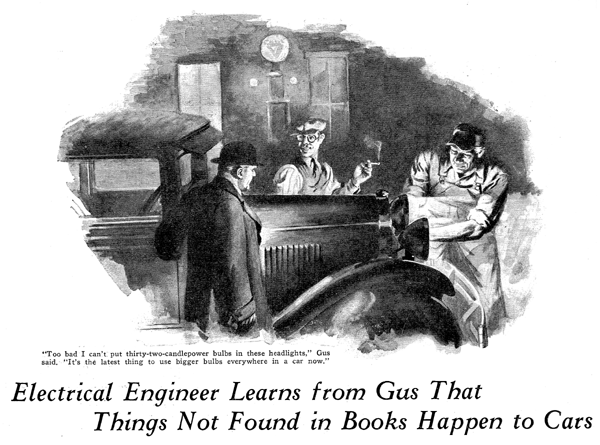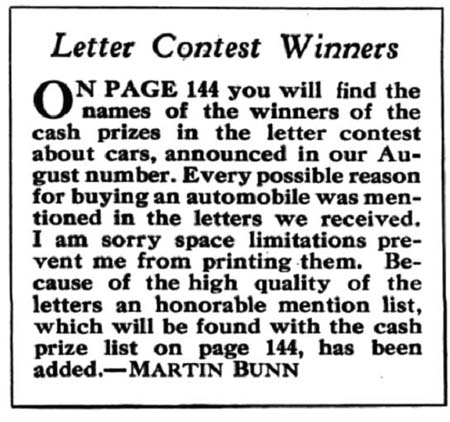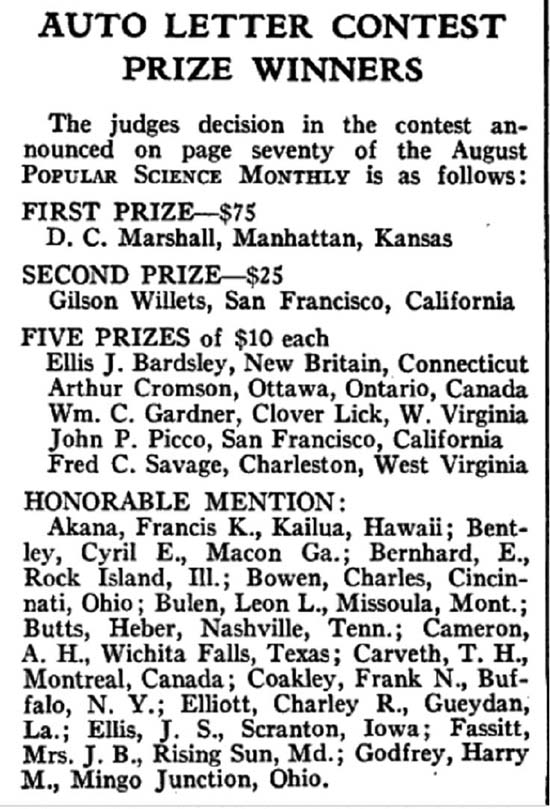November 1930
by Martin
Bunn

"And so I decided that there must be something wrong with the generator and that's what caused the lights to burn out," the car owner concluded positively.
He had drifted up to the Model Garage out of the blackness with all lights out, like a smuggler's boat creeping into port.
Instead of raising the hood and immediately starting to work on the generator as the motorist quite obviously expected, Gus Wilson, veteran auto mechanic and half owner of the Model Garage, began to argue.
"What makes you think it's the generator, mister?" he questioned. "Maybe it's the ground connection on the storage battery."
"Rats!" snorted the car owner. "I'm an electrical engineer. Don't you think I know something about my car's starting and lighting system? The starter works perfectly. If the ground connection will carry a couple of hundred amperes of current to operate the starter, it can't be in bad shape."
"Lots of funny things happen to autos that aren't in the books." Gus grunted as he pulled up the floor boards.
"Hey, Joe!" he called to his partner, Joe Clark. "Plug in the extension cord and bring the trouble light out here, will you?"
Gus pulled the handle of the storage battery and pulled on it. He could lift it almost a quarter of an inch.
"Loose batteries will always cause trouble if you let 'em go long enough," he said half to himself as he loosened the battery terminal of the ground cable.
"Take a look at this, mister," he directed, offering the other the frayed end of the ground cable which had broken off about three inches from the battery.
The car owner looked puzzled as he fingered the frayed end.
"I can't believe it!" he exclaimed. "It just isn't possible to start a car with the ground cable broken. Say, you didn't break that cable yourself?" he questioned in sudden suspicion.
"I didn't have to," Gus grinned. "The loose battery, bouncing around when you went over bumps, did that. When the car was standing still and the battery stayed down where it belonged, the broken ends of the cable pressed together so the starter could turn over the warmed-up motor. If you'd let it alone and tried again tomorrow with a cold motor, it probably wouldn't have swung it past compression. Did you notice the lights get brighter a couple of times before they finally burned out?"
"Every time I went over a bump they flashed up," the car owner admitted. "They finally burned out when I bounced over the car tracks just down the road. I hit them going pretty fast."
"If you'd stayed under twenty miles an hour after you first noticed 'em flash up," Gus suggested as he finished bolting a new ground cable in place, "you could have got here to have it fixed without wanting the price of a new set of bulbs."
"I should have thought of that," the car owner admitted. "If I'd kept the speed down to the point where the generator wasn't producing such high voltage, when the ground circuit opened on the bumps, the lights wouldn't have flashed up from the overload."
"That's the way of it," Gus agreed. "Trouble is, lots of people don't realize that a generator couldn't charge a storage battery at all if it didn't produce voltage higher than the battery voltage. As long as the battery is connected to the generator, the voltage can't get higher than the battery voltage. The flow of current through the battery takes care of that. If you stop that flow by spoiling the ground connection, up goes the voltage, and that means good-by to the light bulbs."
"Why don't you polish those headlight reflectors?" Gus observed as he opened them to replace the bulbs.
"I thought you couldn't polish them without spoiling the surface with scratches."
"You can't make them as good as new," Gus admitted, "but you can increase the light on the road a whole lot. Wash the polished surface gently with soap and water to get rid of the dust and grit. Then polish them with a high grade silver polish and a piece of old, well-washed linen. An old handkerchief that has been through the laundry till it's 'most falling apart is just the thing. Remember to take your time and rub the surface very gently. Don't scrub it."
"Thanks for the tip," said the car owner. I'll take a bit of time off next Sunday and see what I can do."
"Too bad I can't put thirty-two-candle-power bulbs in those headlights," Gus observed as he inserted a pair of the usual twenty-one candlepower size. "Some of the new cars have lamps "approved for use" with thirty-two-candlepower bulbs, and, believe me, they sure do light up the road!"
"I didn't know more than twenty-one-candlepower was legal anywhere," the other exclaimed. "I should think larger lamps would cause too much glare."
"Not a bit of it," said Gus emphatically, "A thirty-two-candlepower bulb in a headlight that's made right, aimed right, and focused right glares less than a three-candlepower bulb might in a headlight that was all out of whack.
"It's the latest thing to use bigger bulbs everywhere in the car's lighting system. You'd be surprised how much better it is to use a fifteen or twenty-one candlepower lamp in the dome light, for instance. You don't have the dome light on while you're driving anyhow, and when you stop it's fine to have plenty of light while you're getting in or out of the car. Another place where a bigger bulb certainly is worth while is in the stop light. I'll put a thirty-two-candlepower bulb in your stop light and the fellow behind is sure to see it even in the daytime."
While he was talking, Gus had been working the brake pedal slowly back and forth. "It's so dim I can't tell whether it's on or not from here. Is it working now, Joe?"
Joe stepped around to the back of the car. "It's lit now -- no, it just went out," he said.
"I thought so," Gus grunted. "A stop light oughtn't to light until the brakes begin to take hold. This one lights the minute your foot touches the pedal. Plenty of drivers keep their feet on the brake pedal most of the time when they're in traffic. When the stoplight is fixed like this, it's always flashing on and off without really meaning anything. After it flashes a few times, without the car slowing down any, the fellow behind gets careless. then, when the brakes really go on, he doesn't heed the warning. Want me to fix it right?"
"Go to it!" the car owner smiled. "Next time I stop here I'll let you talk first!"
END
L. Osbone 2019

